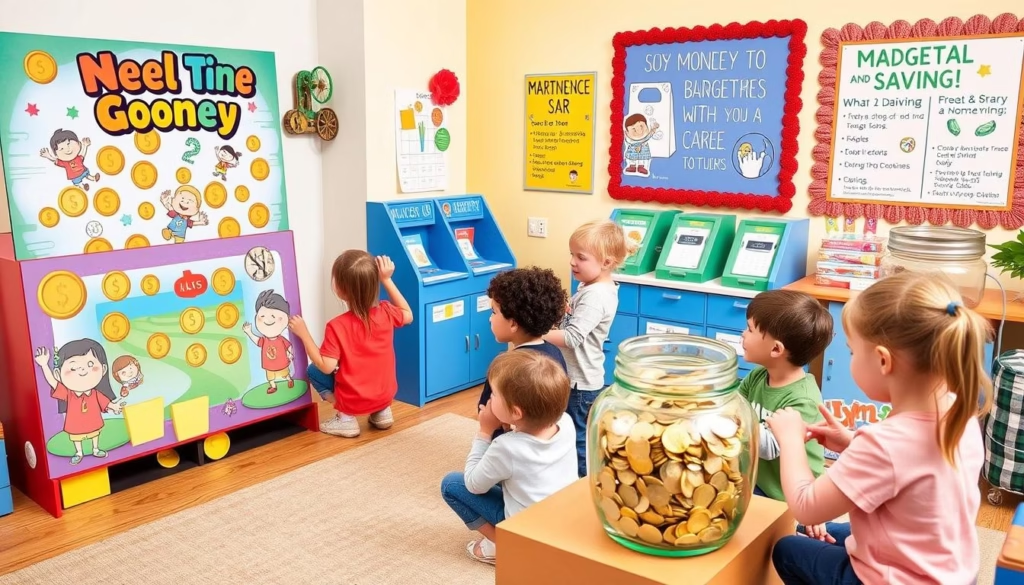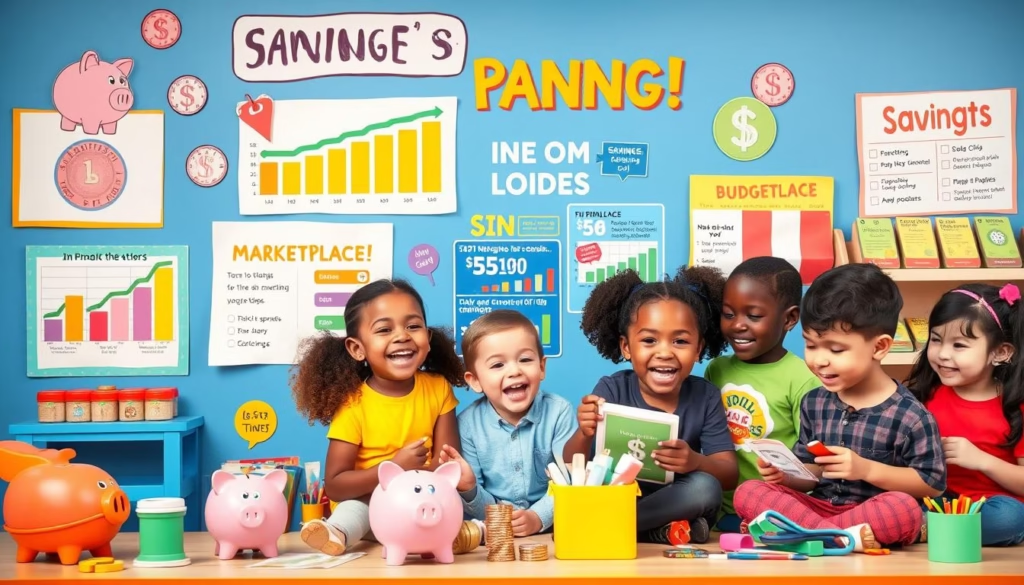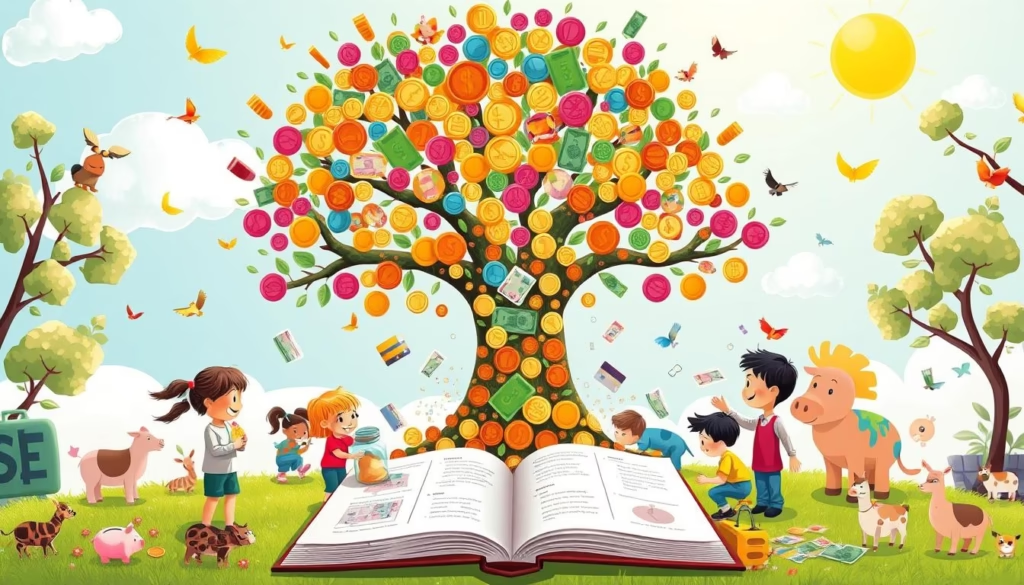Thinking about our kids’ future often leads us to ask: how can we teach them about money? With 76% of Gen Z wanting financial education in school1, and only 25% feeling confident about the stock market1, it’s a pressing question. Our mission is to offer financial education for kids and teens, focusing on money management and financial literacy.
We aim to give our kids a solid financial education. This will help them develop good money habits and understand personal finance. Our goal is to make learning about money fun and easy. We use tools like interactive courses and apps, such as Investmate and World of Money, to teach them about stock trading and finance1.
Key Takeaways
- Financial education is essential for kids and teens to develop healthy money habits and a strong understanding of personal finance.
- There are various resources available to teach financial literacy, including interactive virtual courses and apps.
- Money management for children and youth financial literacy are critical components of financial education.
- Financial education can be made fun and accessible using a variety of tools and resources.
- Our goal is to provide financial education for kids and teens, focusing on money management for children and youth financial literacy.
- By providing a solid foundation in financial education, we can help our kids develop a strong understanding of personal finance and make informed decisions about money.
- Financial literacy is a critical life skill that can benefit our kids throughout their lives.
Why Financial Education is Essential for Kids and Teens
Teaching kids about money is key, and so is financial education for teens. A survey shows 67% of parents think it should start before 122. This means kids need to learn about saving and budgeting early. It helps them develop important life skills.
Financial education is vital for kids and teens. It helps them make smart money choices and avoid debt. The Federal Reserve’s comic book series is a great tool for teaching these lessons. It gives kids a solid base in financial literacy.
Some key benefits of financial education for kids and teens include:
- Improved financial knowledge and decision-making skills
- Increased savings rates and responsible spending habits
- Enhanced ability to distinguish between wants and needs
It’s important to teach kids and teens about money. This way, we can empower them with the knowledge for financial stability and success.

Studies show kids who learn about money early have a better financial future2. A National Endowment for Financial Education study found 93% of parents think it’s key for kids to learn about money2. By focusing on financial education, we can give kids a strong financial foundation for success.
Age-Appropriate Financial Concepts
Teaching kids about money is key for their future. As they get older, they need to learn more about money. Websites like Hands on Banking, sponsored by Wells Fargo, offer great lessons on managing money3. It’s important for teens to learn about budgeting and saving for their financial future4.
Financial education should fit each age group. Young kids start with simple money skills like saving and spending3. Older kids learn about banking and investing4. Teens get to advanced topics like credit and debt3. This way, kids get the tools to make smart money choices.
Some important money lessons include:
- Basic money skills, such as saving and spending
- Intermediate skills, including banking and investing
- Advanced concepts, such as credit and debt management
By teaching these lessons, we help kids develop good money habits for life4. We aim to make financial education fun and easy for young people3.
Fun Activities to Teach Money Skills
Teaching kids about money can be fun and engaging. The right money management games and kids’ finance resources make it exciting. The “Million Bazillion” podcast is a great example, teaching money and economics in a fun way5.
Interactive money lessons, like the Avalanche Money Decision Game, are also great. In this game, teams aim to have 50% of players reach the summit to win5. The Cashy game lets students manage $2,000 and 80% happiness over 10 years5. The 30-day Bill Pay Project and Lego Construction project teach budgeting and decision-making5.
Financial literacy lessons are key for K-12 students. They help develop critical life skills and understand personal finance6. Over 30% of U.S. states require high school personal finance courses6. Fun, interactive activities boost financial literacy and prepare kids for financial success.
| Activity | Description |
|---|---|
| Avalanche Money Decision Game | Team-based game where players must work together to reach the summit |
| Cashy game | Simulation game where students make financial decisions over a 10-year period |
| 30-day Bill Pay Project | Project where students learn to budget and pay bills over a 30-day period |

Allowances: A Great Starting Point
Exploring financial education for kids, we find that allowances play a key role. A study shows that kids with an allowance tend to learn better money habits7. Allowances help kids understand earning and managing money, teaching them to budget and save.
When setting up an allowance, consider the child’s age and needs. A good rule is to give $1 for each year of age per week. So, a 7-year-old gets $7 weekly8. Adjust this amount based on the child’s responsibilities and expenses.
Setting Up an Allowance System
To create a good allowance system, follow these steps:
- Determine the allowance amount based on the child’s age and needs
- Set clear expectations for how the allowance will be used
- Encourage kids to budget and save a portion of their allowance
- Consider using a tool like Modak to track savings goals and provide contributions8
By following these steps and guiding on money management, parents can help kids develop good money habits7. Start early and be consistent. Use allowance tips to teach kids valuable money habits.

Teaching the Value of Saving
Teaching kids to save is key for their financial future. Setting savings goals and using tools like piggy banks and savings accounts helps them develop a saving habit. The Savings Spree app is a great tool for teaching kids about saving and investing, helping parents and educators9.
Starting early is important when teaching kids about saving. Research shows kids as young as 7 can start learning money habits10. Using physical savings trackers like glass jars or printable trackers helps kids see their progress and feel accomplished. As they grow, they can use debit cards and money apps to track their spending and savings10.
Here are some tips for teaching kids the value of saving:
- Set clear savings goals and encourage kids to work towards them
- Use a combination of physical and digital savings tracking methods
- Encourage kids to make smart spending decisions and prioritize saving
By following these tips and using the right tools, parents and educators can help kids build a strong saving foundation. This sets them up for long-term financial success11.

Smart Spending Strategies
Teaching kids about budgeting is key. It’s important to help them know the difference between wants and needs. This is a basic step in learning about money and investing12. It helps them form good spending habits for their future.
A study shows that kids who learn this difference tend to spend wisely12. They understand money’s value and make better choices. Parents can use the 30-day rule for impulse buys to teach this lesson13.
Using digital tools like family finance apps is a great way to teach kids12. These apps let them set savings goals and track spending with a parent’s help. Also, waiting 24 hours before buying can cut down on unnecessary spending13. These methods help kids build a solid base in budgeting and investing, preparing them for financial success later on.

Understanding Credit and Debt
Teaching kids about credit and debt is key to money management. The Federal Reserve’s comic book series shows it’s vital to teach them early14. This knowledge helps them make smart financial choices for the future14.
Learning about money early can prevent debt later14. Teaching them to budget and save is also important for financial stability14. It’s best to start talking about credit and debt when they’re 11-1414.
Teaching kids about using credit wisely is essential. It helps them get better credit scores, which are important for loans and renting14. Using money management apps or games can make learning fun and engaging14.
Some important points for teaching kids about credit and debt are:
- Start teaching them early
- Focus on using credit wisely and the role of credit scores
- Use apps or games to make learning fun
- Include budgeting, saving, and investing in their education

By following these tips, we can equip kids with the skills for smart financial decisions15. This will help them achieve financial stability in the long run15.
Making Investing Accessible
Investing can seem scary, but it doesn’t have to be. We think teaching financial lessons for teens can help them reach their financial dreams. The Investopedia Financial Literacy Survey shows only one in four Gen Zers can explain the stock market to a friend1. This shows we need easy and fun kids’ finance resources.
To make investing easy, start with the basics. It’s important to know the difference between stocks and bonds. Also, understand the risks and rewards of each. There are many financial lessons for teens out there, like online courses and workshops, to teach them about investing1.
Some great kids’ finance resources include:
- Investopedia’s Financial Literacy Survey1
- Hands on Banking website1
- Books like “The Everything Kids’ Money Book”1
By giving teens access to these kids’ finance resources, we can help them build a strong investing foundation. This sets them up for financial success in the long run1.
Resources for Continued Learning
We know how vital it is to give educational finance resources for young people. These help them learn key teen money management skills. So, we’ve gathered a list of useful resources for ongoing learning.
For older kids and young adults, the Hands on Banking website is a top pick. It’s sponsored by Wells Fargo and helps prepare for the finance world16. Sites like TinkerCAD, Khan Academy, and Skillshare also offer coding courses. These courses are fun and designed for young learners17.
Some notable resources include:
- Books and websites for financial education
- Apps and tools for managing money, such as Bankaroo, iAllowance, and PiggyBot17
- Online budgeting exercises, like “Make Money Choices” tailored for K–12 students16
By using these resources, young people can learn good financial habits. They’ll understand money better and become more financially savvy and independent12.
Encouraging Family Discussions about Money
Building a strong foundation of financial literacy starts at home18. Talking openly about money with your kids can greatly impact their financial future14. Kids who learn about money early are 3 times more likely to avoid debt later18. Parents are key in teaching financial responsibility through everyday talks and actions.
Creating an Open Dialogue
Having regular money talks makes kids and teens feel safe to ask questions18. When the whole family is involved in budgeting, it shows everyone’s financial goals are important18. Family budget meetings help everyone understand money better and prepare for making decisions on their own.
Sharing Personal Experiences and Lessons
18 Parents can share their own money stories to teach valuable lessons18. Talking about your successes and mistakes can help kids understand money better14. Learning about credit scores and debt can improve by about 35%.
Conclusion
Building a strong financial foundation for kids and teens is essential for their future success. By teaching them early about saving, budgeting, and investing, we equip them with the skills needed to make smart money decisions. Financial literacy is more than just numbers—it’s about developing responsible habits that last a lifetime. With the right tools and guidance, young people can gain confidence in managing their finances.
Interactive learning, real-life applications, and open conversations at home help reinforce financial knowledge. Using apps, games, and educational resources makes learning about money engaging and practical. Schools and parents play a key role in providing consistent financial education. When kids understand how money works, they can avoid financial pitfalls and build wealth responsibly.
Encouraging smart financial habits at a young age leads to greater financial independence in adulthood. Studies show that those who learn about money early are more likely to save, invest wisely, and avoid debt. Financial education empowers kids to plan for their goals and make informed choices. Teaching personal finance isn’t just beneficial—it’s a necessity in today’s world.
By prioritizing financial education, we set up the next generation for long-term success. Whether through school programs, home discussions, or digital tools, every effort counts. A solid understanding of money gives kids the confidence to navigate their financial future. The best time to start teaching financial literacy is now!
FAQ – Frequently Asked Questions
Why is financial education important for kids and teens?
What are some age-appropriate financial concepts to teach kids?
How can I make learning about money fun for my kids?
How can an allowance system help teach kids about money?
How can I teach my kids the value of saving?
How can I teach my kids smart spending strategies?
How can I teach my kids about credit and debt?
How can I make investing accessible for my teenage kids?
What resources are available for kids and teens to continue learning about personal finance?
How can I encourage family discussions about money with my kids?
Source: The Wall Street Journal | Related articles: X-Twitter/ Gettr




